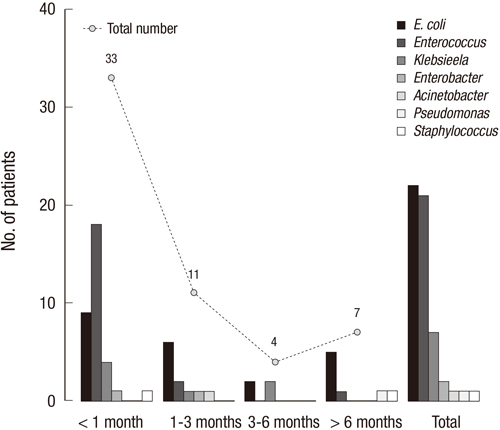1. Hautmann RE, de Petriconi RC, Volkmer BG. Lessons learned from 1,000 neobladders: the 90-day complication rate. J Urol. 2010; 184:990–994.
2. Hautmann RE, de Petriconi RC, Volkmer BG. 25 years of experience with 1,000 neobladders: long-term complications. J Urol. 2011; 185:2207–2212.
3. Studer UE, Burkhard FC, Schumacher M, Kessler TM, Thoeny H, Fleischmann A, Thalmann GN. Twenty years experience with an ileal orthotopic low pressure bladder substitute--lessons to be learned. J Urol. 2006; 176:161–166.
4. Nieuwenhuijzen JA, de Vries RR, Bex A, van der Poel HG, Meinhardt W, Antonini N, Horenblas S. Urinary diversions after cystectomy: the association of clinical factors, complications and functional results of four different diversions. Eur Urol. 2008; 53:834–842.
5. Abe T, Takada N, Shinohara N, Matsumoto R, Murai S, Sazawa A, Maruyama S, Tsuchiya K, Kanzaki S, Nonomura K. Comparison of 90-day complications between ileal conduit and neobladder reconstruction after radical cystectomy: a retrospective multi-institutional study in Japan. Int J Urol. 2014; 21:554–559.
6. Suriano F, Gallucci M, Flammia GP, Musco S, Alcini A, Imbalzano G, Dicuonzo G. Bacteriuria in patients with an orthotopic ileal neobladder: urinary tract infection or asymptomatic bacteriuria? BJU Int. 2008; 101:1576–1579.
7. Wood DP Jr, Bianco FJ Jr, Pontes JE, Heath MA, DaJusta D. Incidence and significance of positive urine cultures in patients with an orthotopic neobladder. J Urol. 2003; 169:2196–2199.
8. Mano R, Baniel J, Goldberg H, Stabholz Y, Kedar D, Yossepowitch O. Urinary tract infections in patients with orthotopic neobladder. Urol Oncol. 2014; 32:50.e9–50.14.
9. Song C, Kim SC, Park J, Moon DH, Ahn H. Renal function change after refluxing type orthotopic ileal substitution. J Urol. 2011; 186:1948–1952.
10. Nishikawa M, Miyake H, Yamashita M, Inoue TA, Fujisawa M. Long-term changes in renal function outcomes following radical cystectomy and urinary diversion. Int J Clin Oncol. 2014; 19:1105–1111.
11. Abdel-Latif M, Mosbah A, El Bahnasawy MS, Elsawy E, Shaaban AA. Asymptomatic bacteriuria in men with orthotopic ileal neobladders: possible relationship to nocturnal enuresis. BJU Int. 2005; 96:391–396.
12. Thulin H, Steineck G, Kreicbergs U, Onelöv E, Ahlstrand C, Carringer M, Holmäng S, Ljungberg B, Malmström PU, Robinsson D, et al. Hygiene and urinary tract infections after cystectomy in 452 Swedish survivors of bladder cancer. BJU Int. 2010; 105:1107–1117.
13. Reyes MA, Nieder AM, Kava BR, Soloway MS, Manoharan M. Does body mass index affect outcome after reconstruction of orthotopic neobladder? Urology. 2007; 69:475–478.
14. Studer UE, Varol C, Danuser H. Orthotopic ileal neobladder. BJU Int. 2004; 93:183–193.
15. Singer M, Deutschman CS, Seymour CW, Shankar-Hari M, Annane D, Bauer M, Bellomo R, Bernard GR, Chiche JD, Coopersmith CM, et al. The Third International Consensus Definitions for Sepsis and Septic Shock (Sepsis-3). JAMA. 2016; 315:801–810.
16. Henningsohn L, Wijkström H, Steven K, Pedersen J, Ahlstrand C, Aus G, Kallestrup EB, Bergmark K, Onelöv E, Steineck G. Relative importance of sources of symptom-induced distress in urinary bladder cancer survivors. Eur Urol. 2003; 43:651–662.
17. Jin XD, Roethlisberger S, Burkhard FC, Birkhaeuser F, Thoeny HC, Studer UE. Long-term renal function after urinary diversion by ileal conduit or orthotopic ileal bladder substitution. Eur Urol. 2012; 61:491–497.
18. Wullt B, Holst E, Steven K, Carstensen J, Pedersen J, Gustafsson E, Colleen S, Månsson W. Microbial flora in ileal and colonic neobladders. Eur Urol. 2004; 45:233–239.
19. Skinner EC, Fairey AS, Groshen S, Daneshmand S, Cai J, Miranda G, Skinner DG. Randomized trial of studer pouch versus t-pouch orthotopic ileal neobladder in patients with bladder cancer. J Urol. 2015; 194:433–439.
20. Large MC, Kiriluk KJ, DeCastro GJ, Patel AR, Prasad S, Jayram G, Weber SG, Steinberg GD. The impact of mechanical bowel preparation on postoperative complications for patients undergoing cystectomy and urinary diversion. J Urol. 2012; 188:1801–1805.
21. Hao WL, Lee YK. Microflora of the gastrointestinal tract: a review. Methods Mol Biol. 2004; 268:491–502.
22. Wullt B, Bergsten G, Carstensen J, Gustafsson E, Gebratsedik N, Holst E, Månsson W. Mucosal host responses to bacteriuria in colonic and ileal neobladders. Eur Urol. 2006; 50:1065–1071.







 PDF
PDF ePub
ePub Citation
Citation Print
Print





 XML Download
XML Download